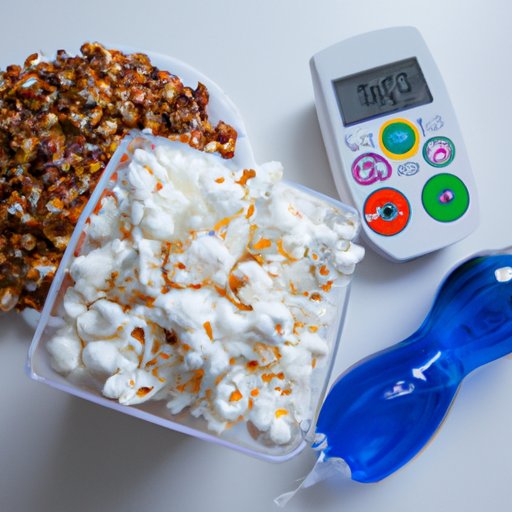Introduction
Diabetes is a chronic metabolic disorder characterized by high levels of glucose in the blood. It’s estimated that over 30 million people in the United States have been diagnosed with diabetes, and many more are at risk due to lifestyle and dietary factors. Managing blood sugar levels is essential for diabetics, as uncontrolled blood sugar can lead to serious complications like nerve damage, kidney failure, and heart disease.
Given the importance of controlling blood sugar levels, many diabetics wonder if popcorn is a healthy snack option. In this article, we’ll explore the potential health benefits of popcorn for diabetics and provide tips on how to incorporate it into a diabetes-friendly diet.

Examining the Nutritional Value of Popcorn for Diabetics
Before diving into the potential health benefits of popcorn for diabetics, it’s important to understand the nutritional breakdown of popcorn. According to the USDA, one cup of popped popcorn contains approximately:
- 82 calories
- 15.6 grams of carbohydrates
- 3.5 grams of fiber
- 1.2 grams of protein
It’s worth noting that the nutritional value of popcorn can vary significantly depending on the type of popcorn and how it’s prepared. For example, microwave popcorn typically contains more fat, sodium, and calories than air-popped popcorn.
Comparing Popcorn to Other Snacks for Diabetics
For many diabetics, snacking can play an important role in managing blood sugar levels. However, not all snacks are created equal when it comes to diabetes management. According to a study published in Diabetes Care, simple carbohydrates like chips and candy can cause a rapid spike in blood sugar levels, while complex carbohydrates like popcorn are less likely to cause a dramatic rise in blood sugar.
When comparing the nutritional value of popcorn to other snack options, it’s important to consider the glycemic index (GI). The GI measures the impact of a food on blood sugar levels and ranks foods on a scale from 0 to 100. Foods with a low GI (0-55) are digested slowly, while foods with a high GI (70-100) cause a quick spike in blood sugar. Popcorn has a GI of 55, meaning it is less likely to cause a rapid increase in blood sugar than other snack options.

Pros and Cons of Eating Popcorn as a Diabetic
While popcorn may be a healthier snack option than chips or candy, there are still potential risks associated with eating popcorn as a diabetic. Here are some of the pros and cons of incorporating popcorn into a diabetes-friendly diet:
Benefits of Eating Popcorn as a Diabetic
- High in fiber, which helps fill you up and can help keep blood sugar levels stable.
- Low in calories, which makes it a great snack for weight management.
- A good source of antioxidants, which can help protect against cell damage and reduce inflammation.
Potential Risks Associated with Eating Popcorn as a Diabetic
- Can contain added sugar, salt, and unhealthy fats, which can increase calorie intake and raise blood sugar levels.
- Most types of microwave popcorn contain trans fats, which can increase bad cholesterol levels.
Can Diabetics Enjoy Popcorn without Raising Blood Sugar Levels?
The answer to this question depends on several factors, including portion size and timing. According to the American Diabetes Association, it’s important to eat snacks in moderation and spread them out throughout the day to avoid spikes in blood sugar levels. This means that diabetics should limit their intake of popcorn to no more than two cups per day, and should avoid eating it close to mealtime.
In addition, it’s important to choose the right type of popcorn and prepare it properly. Air-popped popcorn is a healthier option than microwave popcorn, as it contains fewer calories and less fat. Additionally, it’s best to avoid adding butter, oil, or other toppings to popcorn, as these can increase calorie and fat intake.
How to Incorporate Popcorn into a Diabetes-Friendly Diet
Incorporating popcorn into a diabetes-friendly diet isn’t as difficult as it may seem. Here are some tips for making popcorn a part of your diabetes management plan:
Choose the Right Popcorn Products
When shopping for popcorn, it’s important to read nutrition labels carefully. Look for products that are low in calories, fat, and sodium, and free of added sugars. Also, be sure to avoid microwave popcorn, as it typically contains trans fats and other unhealthy ingredients.
Try Low-Calorie Recipes Featuring Popcorn
Popcorn can be a creative and delicious addition to any meal. Try adding popcorn to salads, soups, or side dishes for a tasty and nutritious twist. Also, check out online recipes for low-calorie popcorn snacks like popcorn trail mix or popcorn balls.

Popular Popcorn Brands for Diabetics
If you’re looking for a convenient way to enjoy popcorn without compromising your diabetes management plan, there are several popular brands that offer healthy popcorn products. Here are a few of the top popcorn brands for diabetics:
- SkinnyPop: SkinnyPop offers a variety of low-calorie popcorn products that are free of preservatives and artificial flavors. Plus, they’re non-GMO and gluten-free.
- Popcorners: Popcorners’ products are made with whole-grain corn and contain no artificial colors, flavors, or preservatives. They also offer several vegan and gluten-free options.
- Angie’s Boomchickapop: Angie’s Boomchickapop is a fan favorite among diabetics. Their products are made with non-GMO ingredients and contain no artificial colors, flavors, or preservatives.
What are the Health Benefits of Eating Popcorn for Diabetics?
In addition to its potential impact on blood sugar levels, popcorn may offer other potential health benefits for diabetics. Here are a few of the potential benefits of eating popcorn:
Antioxidants
Popcorn is a good source of antioxidants, which can help protect against cell damage and reduce inflammation. According to a study published in the journal Nutrition Research, popcorn contains higher levels of antioxidants than many other grains and vegetables.
Cholesterol Levels
Eating popcorn may also help improve cholesterol levels. A study published in the journal Clinical Nutrition found that participants who ate popcorn daily had lower total cholesterol levels and improved HDL (good) cholesterol levels compared to those who did not eat popcorn.
Conclusion
Popcorn can be a healthy snack for diabetics when portion size and timing are managed. When choosing popcorn products, look for those with minimal ingredients and no added sugars, salts, or fats. Also, be sure to limit your intake of popcorn to no more than two cups per day and avoid eating it close to mealtime. Finally, try incorporating popcorn into salads, soups, or side dishes for a nutritious and flavorful meal.
(Note: Is this article not meeting your expectations? Do you have knowledge or insights to share? Unlock new opportunities and expand your reach by joining our authors team. Click Registration to join us and share your expertise with our readers.)
